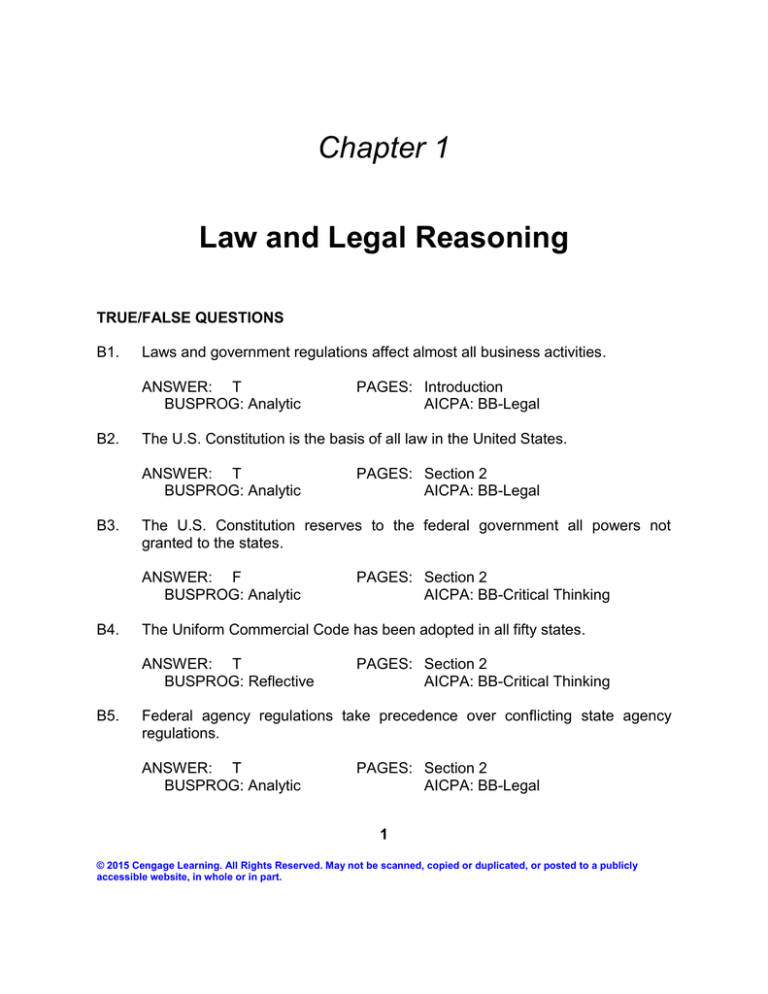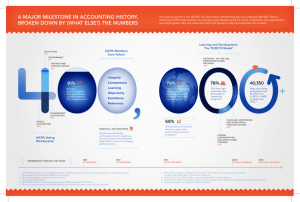
Chapter 1
Law and Legal Reasoning
TRUE/FALSE QUESTIONS
B1.
Laws and government regulations affect almost all business activities.
ANSWER: T
BUSPROG: Analytic
B2.
The U.S. Constitution is the basis of all law in the United States.
ANSWER: T
BUSPROG: Analytic
B3.
PAGES: Section 2
AICPA: BB-Critical Thinking
The Uniform Commercial Code has been adopted in all fifty states.
ANSWER: T
BUSPROG: Reflective
B5.
PAGES: Section 2
AICPA: BB-Legal
The U.S. Constitution reserves to the federal government all powers not
granted to the states.
ANSWER: F
BUSPROG: Analytic
B4.
PAGES: Introduction
AICPA: BB-Legal
PAGES: Section 2
AICPA: BB-Critical Thinking
Federal agency regulations take precedence over conflicting state agency
regulations.
ANSWER: T
BUSPROG: Analytic
PAGES: Section 2
AICPA: BB-Legal
1
© 2015 Cengage Learning. All Rights Reserved. May not be scanned, copied or duplicated, or posted to a publicly
accessible website, in whole or in part.
2
TEST BANK B—UNIT ONE: THE LEGAL ENVIRONMENT OF BUSINESS
B6.
Common law is a term for the laws that are familiar to most of us.
ANSWER: F
BUSPROG: Analytic
B7.
Decisions by higher courts are not binding on lower courts.
ANSWER: F
BUSPROG: Analytic
B8.
PAGES: Section 3
AICPA: BB-Legal
Stare decisis is a doctrine obligating judges to help persons who have failed to
protect their own rights.
ANSWER: F
BUSPROG: Analytic
B9.
PAGES: Section 3
AICPA: BB-Critical Thinking
PAGES: Section 3
AICPA: BB-Legal
Courts are not obligated to follow precedents.
ANSWER: F
BUSPROG: Reflective
PAGES: Section 3
AICPA: BB-Critical Thinking
B10. In most legal controversies, there is one single correct result.
ANSWER: F
BUSPROG: Analytic
PAGES: Section 3
AICPA: BB-Critical Thinking
B11. Although cases may be similar, no two cases are ever identical in all respects.
ANSWER: T
BUSPROG: Analytic
PAGES: Section 3
AICPA: BB-Critical Thinking
B12. Each judge had his or her personal beliefs and philosophy, which shape the
legal reasoning process.
ANSWER: T
BUSPROG: Reflective
PAGES: Section 3
AICPA: BB-Critical Thinking
B13. Clearly, a judge’s function is to make the laws.
ANSWER: F
BUSPROG: Analytic
PAGES: Section 4
AICPA: BB-Critical Thinking
© 2015 Cengage Learning. All Rights Reserved. May not be scanned, copied or duplicated, or posted to a publicly
accessible website, in whole or in part.
CHAPTER 1: LAW AND LEGAL REASONING
3
B14. The courts, in interpreting statutory law, often rely on the common law as a
guide to what the legislators intended.
ANSWER: T
BUSPROG: Analytic
PAGES: Section 4
AICPA: BB-Critical Thinking
B15. A jury’s good sense and careful consideration of consequences is known as
jurisprudence.
ANSWER: F
BUSPROG: Reflective
PAGES: Section 4
AICPA: BB-Critical Thinking
B16. Procedural law consists of all laws that outline the methods of enforcing rights.
ANSWER: T
BUSPROG: Analytic
PAGES: Section 5
AICPA: BB-Legal
B17. A citation identifies the publication in which a legal authority can be found.
ANSWER: T
BUSPROG: Analytic
PAGES: Section 6
AICPA: BB-Research
B18. The decisions made by the courts establish the boundaries of the law as it
applies to almost all business relationships.
ANSWER: T
BUSPROG: Analytic
PAGES: Section 7
AICPA: BB-Critical Thinking
B19. The party against whom a lawsuit is brought is the plaintiff or petitioner.
ANSWER: F
BUSPROG: Analytic
PAGES: Section 7
AICPA: BB-Critical Thinking
B20. When all the judges (or justices) agree on a decision, a majority opinion is
written for the entire court.
ANSWER: F
BUSPROG: Reflective
PAGES: Section 7
AICPA: BB-Critical Thinking
© 2015 Cengage Learning. All Rights Reserved. May not be scanned, copied or duplicated, or posted to a publicly
accessible website, in whole or in part.
4
TEST BANK B—UNIT ONE: THE LEGAL ENVIRONMENT OF BUSINESS
MULTIPLE-CHOICE QUESTIONS
B1.
Data Analytics, Inc., is a corporation engaged in the business of compiling,
analyzing, and marketing data. To accomplish its purposes, Data Analytics
obtains financing, and hires and fires employees. Laws and government
regulations affect such business activities as
a.
b.
c.
d.
hiring and firing decisions.
the manufacturing and marketing of products.
business financing.
all of the choices.
ANSWER: D
BUSPROG: Reflective
B2.
The U.S. Congress enacts a new federal statute that imposes liability on
businesses hiring employees without verifying their citizenship status. This
statute applies
a.
b.
c.
d.
only to businesses not covered by state law.
only to those states that consent to apply it.
to all of the states.
to none of the states.
ANSWER: C
BUSPROG: Reflective
B3.
PAGES: Section 1
AICPA: BB-Critical Thinking
PAGES: Section 2
AICPA: BB-Legal
A provision in the California state constitution conflicts with a provision in the
U.S. Constitution. If challenged
a.
b.
c.
d.
neither provision will be enforced.
the provisions will be balanced to reach a compromise.
the state provision, not the U.S. Constitution, will be enforced.
the U.S. Constitution, not the state provision, will be enforced.
ANSWER: D
BUSPROG: Reflective
PAGES: Section 2
AICPA: BB-Legal
© 2015 Cengage Learning. All Rights Reserved. May not be scanned, copied or duplicated, or posted to a publicly
accessible website, in whole or in part.
CHAPTER 1: LAW AND LEGAL REASONING
B4.
The Pennsylvania legislature enacts a state law that violates the U.S.
Constitution. This law can be enforced by
a.
b.
c.
d.
no one.
the federal government only.
the state of Pennsylvania only.
the United States Supreme Court only.
ANSWER: A
BUSPROG: Reflective
B5.
PAGES: Section 2
AICPA: BB-Legal
The Bay City Planning Department, the Coastal County Zoning Commission,
the Delaware Environmental Quality Agency, and the U.S. Bureau of Land
Management issue regulations. These rules constitute
a.
b.
c.
d.
administrative law.
case law.
stare decisis.
statutory law.
ANSWER: A
BUSPROG: Reflective
B6.
5
PAGES: Section 2
AICPA: BB-Critical Thinking
Charles is a federal judge whose judicial decisions are part of case law, which
does not include interpretations of
a.
b.
c.
d.
regulations created by administrative agencies.
constitutional provisions.
statutes enacted by legislatures.
sound bites in the media.
ANSWER: D
BUSPROG: Reflective
PAGES: Section 2
AICPA: BB-Legal
© 2015 Cengage Learning. All Rights Reserved. May not be scanned, copied or duplicated, or posted to a publicly
accessible website, in whole or in part.
6
TEST BANK B—UNIT ONE: THE LEGAL ENVIRONMENT OF BUSINESS
B7.
Much of American law is based on
a.
b.
c.
d.
the English legal system.
the French legal system.
Greek civil law.
ancient Chinese law.
ANSWER: A
BUSPROG: Reflective
B8.
Bob’s Big Burgers n’ Shakes Restaurant brings a suit, seeking a remedy at law.
A remedy at law is
a.
b.
c.
d.
monetary damages.
a decree of specific performance.
a judicial proceeding for the resolution of a dispute.
an injunction.
ANSWER: A
BUSPROG: Reflective
B9.
PAGES: Section 3
AICPA: BB-Legal
PAGES: Section 3
AICPA: BB-Critical Thinking
Larry enters into a contract with Motivational Education Services to host a
panel discussion at a sales conference. When the conference is postponed
indefinitely, Larry asks a court to cancel the contract and return the parties to
the positions that they held before its formation. This request involves
a.
b.
c.
d.
specific performance.
an injunction.
rescission.
an action that the court cannot order.
ANSWER: C
BUSPROG: Reflective
PAGES: Section 3
AICPA: BB-Legal
© 2015 Cengage Learning. All Rights Reserved. May not be scanned, copied or duplicated, or posted to a publicly
accessible website, in whole or in part.
CHAPTER 1: LAW AND LEGAL REASONING
7
B10. Maggie and Nate enter into a contract for the sale of a car, but Nate later
refuses to deliver the car. Maggie asks a court to order Nate to perform as
promised. Ordering a party to perform what was promised is
a.
b.
c.
d.
specific performance.
damages.
rescission.
beyond the court’s authority.
ANSWER: A
BUSPROG: Reflective
PAGES: Section 3
AICPA: BB-Decision Modeling
B11. Jane enters into a contract with Jill to provide 100 roses for a dinner party. Jill
fails to deliver the roses. Jane initiates a suit against Jill, asking the court to
order Jill to refund Jane’s payment. Jane is
a.
b.
c.
d.
the plaintiff.
the defendant.
the binding authority.
the persuasive authority.
ANSWER: A
BUSPROG: Analytic
PAGES: Section 3
AICPA: BB-Legal
B12. Sara believes that she has a strong case against Tom for the breach of an
employment contract. Despite this belief, Sara cannot file a suit against Tom
after the expiration of the time allowed for the filing under
a.
b.
c.
d.
a statute of limitations.
the doctrine of laches.
an equitable maxim.
the remedy at law.
ANSWER: A
BUSPROG: Reflective
PAGES: Section 3
AICPA: BB-Legal
© 2015 Cengage Learning. All Rights Reserved. May not be scanned, copied or duplicated, or posted to a publicly
accessible website, in whole or in part.
8
TEST BANK B—UNIT ONE: THE LEGAL ENVIRONMENT OF BUSINESS
B13. In the case of Retail Sales Corp. v. Trucking Delivery Co., the court may rule
contrary to a precedent if the court decides that the precedent
a.
b.
c.
d.
is incorrect or inapplicable.
is not in line with the judge’s personal values.
would lead to unintended consequences.
would not bring about the result the judge prefers.
ANSWER: A
BUSPROG: Reflective
PAGES: Section 3
AICPA: BB-Legal
B14. Karen is a judge hearing the case of Local Dispatch Co. v. National Transport
Corp. Applying the relevant rule of law to the facts of the case requires Karen
to find cases on point—previously decided cases that, in relation to the case
under consideration, are
a.
b.
c.
d.
as different as possible.
as similar as possible.
at odds.
exactly identical.
ANSWER: B
BUSPROG: Analytic
PAGES: Section 3
AICPA: BB-Legal
B15. Juan is a judge. How Juan and the judges in other courts interpret a particular
statute determines
a.
b.
c.
d.
how that statute will be applied.
how the law needs to be changed.
how the common law should be codified.
nothing.
ANSWER: A
BUSPROG: Analytic
PAGES: Section 3
AICPA: BB-Legal
© 2015 Cengage Learning. All Rights Reserved. May not be scanned, copied or duplicated, or posted to a publicly
accessible website, in whole or in part.
CHAPTER 1: LAW AND LEGAL REASONING
9
B16. To Sam, the written law of a particular society at a particular time is most
significant. Sam is a
a.
b.
c.
d.
legal positivist.
person who adheres to the historical school of legal thought.
legal realist.
person who adheres to the natural law tradition.
ANSWER: A
BUSPROG: Analytic
PAGES: Section 4
AICPA: BB-Critical Thinking
B17. Dave and Ellen enter into a contract via e-mail. When a dispute arises over the
performance of the deal, Dave files a suit against Ellen. The emerging body of
law that governs transactions conducted via the Internet is referred to by the
term
a.
b.
c.
d.
cyberlaw.
civil law.
equitable maxims.
IRAC.
ANSWER: A
BUSPROG: Reflective
PAGES: Section 5
AICPA: BB-Critical Thinking
B18. Beth is a victim of Carl’s violation of a criminal law. Criminal law is concerned
with
a.
b.
c.
d.
the prosecution of private individuals by other private individuals.
the prosecution of public officials by private individuals.
the relief available when a person’s rights are violated.
wrongs committed against the public as a whole.
ANSWER: D
BUSPROG: Reflective
PAGES: Section 5
AICPA: BB-Research
© 2015 Cengage Learning. All Rights Reserved. May not be scanned, copied or duplicated, or posted to a publicly
accessible website, in whole or in part.
10
TEST BANK B—UNIT ONE: THE LEGAL ENVIRONMENT OF BUSINESS
B19. The Nebraska Supreme Court issues an opinion that can be found at 285 Neb.
88, 825 N.W.2d 429. “285” is
a.
b.
c.
d.
the number of the volume in the official reports of the court’s decisions.
the number of the volume in Thomson Reuter’s unofficial publication of
the court’s decisions.
a page number in the appropriate volume.
the number of the case in the sequence decided by the state’s highest
court.
ANSWER: A
BUSPROG: Reflective
PAGES: Section 6
AICPA: BB-Research
B20. Operational Processes, Inc., appeals a decision against it, in favor of Precision
Manufacturing Corporation, from a lower court to a higher court. Operational
Processes is
a.
b.
c.
d.
the appellant.
the appellee.
the defendant.
the respondent.
ANSWER: A
BUSPROG: Reflective
PAGES: Section 7
AICPA: BB-Legal
ESSAY QUESTIONS
B1.
In a lawsuit between Cloud Computing Corporation and Digital Enterprises,
Inc., the court applies the doctrine of stare decisis. What is this doctrine? What
does this doctrine have to do with the American legal system?
ANSWER: In a common law legal system, past judicial decisions are binding
in current disputes with similar facts. This feature of the common law, which is
the basis of the American legal system, is unique because, unlike the law in
other legal systems, it is judge-made law. Within the common law system,
when possible, judges attempt to be consistent and to base their decisions on
the principles suggested by earlier cases. The body of principles and doctrines
that form the common law emerged over time as judges applied the principles
announced in earlier cases to subsequent legal controversies.
© 2015 Cengage Learning. All Rights Reserved. May not be scanned, copied or duplicated, or posted to a publicly
accessible website, in whole or in part.
CHAPTER 1: LAW AND LEGAL REASONING
11
The practice of deciding cases with reference to former decisions, or
precedents—the cornerstone of the American legal system—is called the
doctrine of stare decisis. Under this doctrine, judges are obligated to follow the
precedents established within their jurisdictions. This helps courts to be more
efficient and makes the law more stable and predictable.
PAGES:
Section 3
BUSPROG: Reflective
B2.
AICPA: BB-Critical Thinking
For a business law class, Sierra reads and briefs several court opinions using
the IRAC method of legal reasoning. What do the letters I, R, A, and C
abbreviate? What are the steps in the IRAC method?
ANSWER: The letters I, R, A, and C are the first letters of “Issue,” “Rule,”
“Application,” and “Conclusion.”
The IRAC method of legal reasoning requires Sierra or any other
student or reader to first summarize the important facts of a legal case and
state the salient issue or issues. The second step is to determine and set out
the rule of law that applies to the facts to resolve the issue. The third step is to
apply that rule to those facts. The application of the rule requires an answer to
the question posed by the issue. This answer may involve one or more different
types of legal reasoning, but those reasons should be thought out and
expressed clearly. Finally, the conclusion derived from the application of the
rule to the facts is stated. This is sometimes referred to as the result or the
outcome in a case—who won; who lost; what the award, if any, consists of; or
what the parties are, or are not, required to do next.
PAGES:
Section 3
BUSPROG: Reflective
AICPA: BB-Legal
© 2015 Cengage Learning. All Rights Reserved. May not be scanned, copied or duplicated, or posted to a publicly
accessible website, in whole or in part.





